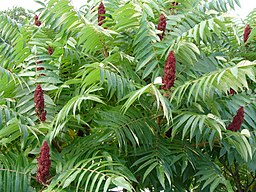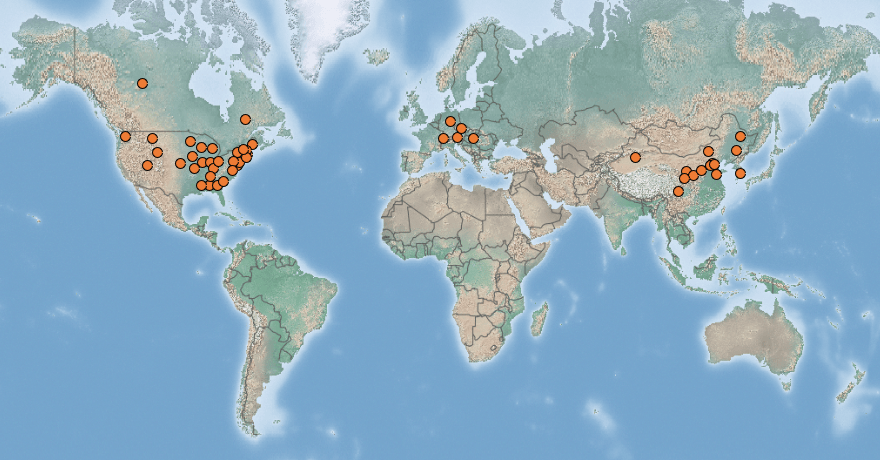 |
Stag’s-horn sumach | Status LU: established. 1st record: LU <1875, ITW 1986. |
 |
Essegbam | Status Eur.: established. 1st record: unkn. |
 |
Sumac vinaigrier | RA: ISEIA: B1, Watch List. Harmonia+: 0,28. |
 |
Essigbaum | Wikipedia:     | Wikispecies: | Wikispecies:  | CABI | CABI |
 |
Fluweelboom | Back to the list of neophytes |
Contents
Report the species
→ Report Rhus typhina to the National Museum of Natural History.
Brief description

Status and distribution in Luxembourg
Records of Rhus typhina L. in Luxembourg. Data source: Recorder-Lux, iNaturalist & GBIF, 2025-06-30.
Rhus typhina L. is first mentioned for Luxembourg by Koltz (1875: 38); “Native to Canada. Introduced from ancient times and also cultivated under the name of R. canadensis.” The 1st record is thus anterior to 1875.
The first documentation of Stag’s-horn sumach dates from 1886, when Jean Feltgen (1833-1904) included a specimen from a garden in Berschbach in his herbarium (Specimen № 15466, MNHNL 2000-). The next documentation of Stag’s-horn Sumach dates from 1981. It was recorded on 9th September 1981 by Léopold Reichling (1921-2009) in Avenue Guillaume in the Belair district of Luxembourg City (MNHNL 2000-). The species was first documented in the wild by Léopold Reichling on 26 June 1986 at Léiffrächen on the Bromeschbierg, municipality of Kayl (MNHNL 2000-).
Until 2012 only four occurrences were documented in Recorder-Lux. In 2013, systematic inventories of invasive species along Luxembourg’s main watercourses (Pfeiffenschneider et al. 2014a) and along the railway lines (Pfeiffenschneider et al. 2014b) showed that the species is more common in Luxembourg than earlier data suggested.
Currently, 76 records are accessible through the MNHNL-mdata portal (MNHNL, iNaturalist & GBIF 2019).
According to Lambinon & Verloove (2012: 463) Rhus typhina (Syn.: R. hirta) is planted in parks, as well as R. glabra and their hybrid R. ×pulvinata.
Risk assessment
ISEIA protocol
B1 (2+2+3+3) = Watch List (Ries et al. 2013: 18).
Harmonia+ protocol
Overall risk score 0,28 = (Overall Invasion score 0,57 x Overall Impact score 0,50) (Ries et al. 2020).
 Invasion
Invasion0,50

 Impact
Impact0,28

 Risk
RiskWorldwide distribution
Bibliography
- Branquart, E., P. Dupriez , S. Vanderhoeven, W. Van Landuyt, F. Van Rossum & F. Verloove, 2011. Harmonia database: Rhus typhina L. Harmonia version 1.2, Belgian Forum on Invasive Species. URL: http://ias.biodiversity.be [accessed on 2019-10-28]
- CABI, 2019. Rhus typhina. In: Invasive Species Compendium. Wallingford, UK: CAB International. URL: www.cabi.org/isc [accessed 2020-03-02]
- Koltz, J.-P.-J., 1875. Dendrologie luxembourgeoise. Catalogue des arbres, arbrisseaux et arbustes spontanés, subspontanés ou introduits dans la culture du Grand-Duché de Luxembourg. Imprimerie V. Buck, Luxembourg, 217 pp.
- Lambinon J. & F. Verloove, 2012. Nouvelle flore de la Belgique, du grand-duché de Luxembourg, du Nord de la France et des régions voisines. Sixième édition. Avec la collaboration de L. Delvosalle, B. Toussaint, D. Geerinck, I. Hoste, F. Van Rossum, B. Cornier, R. Schumacker, A. Vanderpoorten et H. Vannerom. Jardin botanique national de Belgique, Meise. CXXXIX + 1195 pp. ISBN : 9789072619884.
- MNHNL, 2000-. Rhus typhina L. in Recorder-Lux, database on the natural heritage of the Grand Duchy of Luxembourg. Musée national d’histoire naturelle, Luxembourg. URL: https://mdata.mnhn.lu [Accessed 2019-09-05]
- MNHNL, iNaturalist & GBIF, 2019. Rhus typhina L. in MNHNL-mdata, online portal combining species observation from Recorder-Lux, iNaturalist and GBIF. National Museum of Natural History, Luxembourg. URL: https://mdata.mnhn.lu [Accessed 2019-09-06]
- Pfeiffenschneider, M., P. Gräser & C. Ries, 2014a. Distribution of selected neophytes along the main rivers of Luxembourg. Bull. Soc. Nat. luxemb. 115: 101-108. [PDF 3668 KB]
- Pfeiffenschneider, M., P. Gräser & C. Ries, 2014b. Distribution of selected neophytes along the national railway network of Luxembourg. Bull. Soc. Nat. luxemb. 115: 95-100. [PDF 1457 KB]
- Ries, C. & Y. Krippel, 2021. First records of 56 invasive alien vascular plants in Luxembourg. Bulletin de la Société des naturalistes luxembourgeois 123: 115-127. [PDF 241 KB]
- Ries, C., Y. Krippel & M. Pfeiffenschneider, 2020. Risk assessment after the Harmonia+ protocol of invasive alien vascular plant species in Luxembourg. Bull. Soc. Nat. luxemb. 122: 197-205. [PDF 132 KB]
- Ries, C., Y. Krippel, M. Pfeiffenschneider & S. Schneider, 2013. Environmental impact assessment and black, watch and alert list classification after the ISEIA Protocol of non-native vascular plant species in Luxembourg. Bull. Soc. Nat. luxemb. 114: 15-21. [PDF 652 KB]
Suggested citation of this webpage
Ries, C., M. Pfeiffenschneider & Y. Krippel (Eds.), 2025. Rhus typhina L. In: neobiota.lu - Invasive Alien Species in Luxembourg. National Museum of Natural History, Luxembourg. URL: https://neobiota.lu/rhus-typhina/ [Accessed 2025-06-30].
Page content last updated on 2021-03-11.


